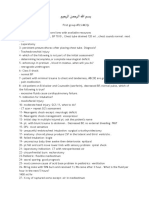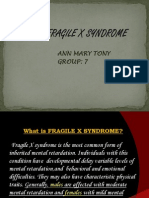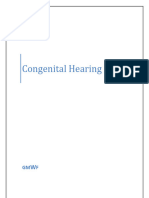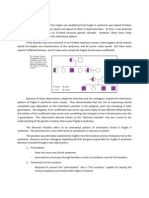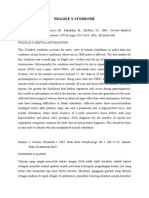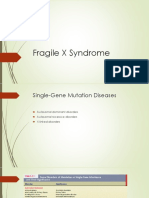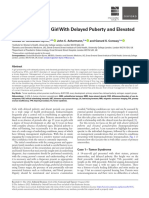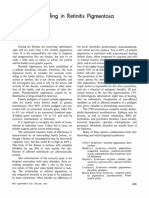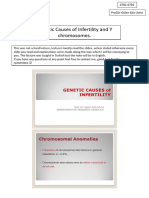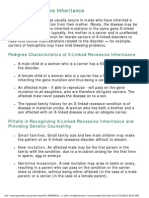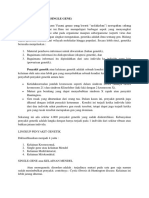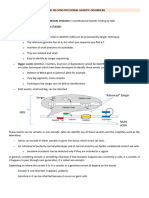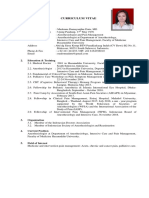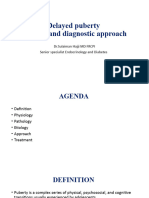0 ratings0% found this document useful (0 votes)
28 viewsFragile X Syndrome
Fragile X Syndrome
Uploaded by
adamFragile X syndrome is caused by a mutation on the X chromosome and is the most common inherited cause of intellectual disability. It causes intellectual disabilities and behavioral issues in affected individuals. While premutation carriers do not usually show symptoms, they have an increased risk of fragile X-associated tremor/ataxia syndrome (FXTAS) or premature ovarian failure. There are no cures for fragile X syndrome, so treatment focuses on education and managing behavioral problems. The risk of having an affected child depends on factors like the size of the parent's premutation and the sex of the child.
Copyright:
© All Rights Reserved
Available Formats
Download as PDF, TXT or read online from Scribd
Fragile X Syndrome
Fragile X Syndrome
Uploaded by
adam0 ratings0% found this document useful (0 votes)
28 views2 pagesFragile X syndrome is caused by a mutation on the X chromosome and is the most common inherited cause of intellectual disability. It causes intellectual disabilities and behavioral issues in affected individuals. While premutation carriers do not usually show symptoms, they have an increased risk of fragile X-associated tremor/ataxia syndrome (FXTAS) or premature ovarian failure. There are no cures for fragile X syndrome, so treatment focuses on education and managing behavioral problems. The risk of having an affected child depends on factors like the size of the parent's premutation and the sex of the child.
Original Title
Fragile X syndrome
Copyright
© © All Rights Reserved
Available Formats
PDF, TXT or read online from Scribd
Share this document
Did you find this document useful?
Is this content inappropriate?
Fragile X syndrome is caused by a mutation on the X chromosome and is the most common inherited cause of intellectual disability. It causes intellectual disabilities and behavioral issues in affected individuals. While premutation carriers do not usually show symptoms, they have an increased risk of fragile X-associated tremor/ataxia syndrome (FXTAS) or premature ovarian failure. There are no cures for fragile X syndrome, so treatment focuses on education and managing behavioral problems. The risk of having an affected child depends on factors like the size of the parent's premutation and the sex of the child.
Copyright:
© All Rights Reserved
Available Formats
Download as PDF, TXT or read online from Scribd
Download as pdf or txt
0 ratings0% found this document useful (0 votes)
28 views2 pagesFragile X Syndrome
Fragile X Syndrome
Uploaded by
adamFragile X syndrome is caused by a mutation on the X chromosome and is the most common inherited cause of intellectual disability. It causes intellectual disabilities and behavioral issues in affected individuals. While premutation carriers do not usually show symptoms, they have an increased risk of fragile X-associated tremor/ataxia syndrome (FXTAS) or premature ovarian failure. There are no cures for fragile X syndrome, so treatment focuses on education and managing behavioral problems. The risk of having an affected child depends on factors like the size of the parent's premutation and the sex of the child.
Copyright:
© All Rights Reserved
Available Formats
Download as PDF, TXT or read online from Scribd
Download as pdf or txt
You are on page 1of 2
predisposed to expand.
Although premutations are relatively Management
common, progression to a full mutation has been observed
No curative treatments are currently available for fragile X
only on a limited number of haplotypes; that is, there is a
syndrome. Therapy focuses on educational intervention and
hap_l�type predisposition to expansion. This haplotype predis
pharmacological management of the behavioral problems.
posmon may relate partly to the presence of a few AGG
triplets embedded within the string of CGG repeats· these
AGG triplets appear to inhibit expansion of the string ;f CGG INHERITANCE RISK
repeats, and their absence in some haplotypes therefore may
predispose to expansion. The risk that a woman with a premutation will have an
affected child is determined by the size of the premutation, the
sex of the fetus, and the family history. Empirically, the risk
Phenotype and Natural History to a premutation carrier of having an affected child can be as
high as 50% for each male child and 25% for each female
Fragile X syndrome causes moderate intellectual disability in
child but depends on the size of the premutation. On the basis
affected males and mild intellectual deficits in affected females.
of analysis of a relatively small number of carrier mothers, the
Most affected individuals also have behavioral abnormalities
recurrence risk appears to decline as the premutation decreases
including hyperactivity, hand flapping or biting, temper tan '.
from 100 to 59 repeats. Prenatal testing is available by use of
trums, poor eye contact, and autistic features. The physical
fetal DNA derived from chorionic villi or amniocytes.
features of males vary in relation to puberty such that before
puberty, they have somewhat large heads but few other dis
t�c�ive _ features; after puberty, they frequently have more
d1Stmct1ve features (long face with prominent jaw and fore
head, large ears, and macro-orchidism). Because these clinical REFERENCES
findings are not unique to fragile X syndrome, the diagnosis
depends on molecular detection of mutations. Patients with Besterman AO, Wilke SA, Milligan TE, et al Towards an understanding of neuro
_
fragile X syndrome have a normal life span. psych1atnc man1festat1ons in fragile X premutation carriers, Future Neural9:227-
239, 2014.
Nearly all males and 40% to 50% of females who inherit
Hagerman A, Hagerman P: Advances in clinical and molecular understanding of the
a full mutation will have fragile X syndrome. The severity of
FMRl premutation and fragile X-associated tremor/ataxia syndrome, Lancet
the phenotype depends on repeat length mosaicism and repeat Neural 12786-798, 2013.
methylation (see Fig. C-17). Because full mutations are mitoti Saul RA, Tarleton JC FMR/-related disorders. Available from http://www.ncbi
cally unstable, some patients have a mixture of cells with .nlm.nih gov/books/NB Kl 384/
repeat lengths ranging from premutation to full mutation Tassone F: Newborn screening for fragile X syndrome, JAMA Neural 71355-359,
(repeat length mosaicism). All males with repeat length mosa 2014.
icism are affected but often have higher mental function than
those with a full mutation in every cell; females with repeat
lenrh mosaicism _ are normal to fully affected. Similarly, some
patients have a rruxture of cells, with and without methylation
of the CGG repeat (repeat methylation mosaicism). All males
with methylation mosaicism are affected but often have higher
mental function than those with a hypermethylation in every
cell; females with methylation mosaicism are normal to fully
affected. Very rarely, patients have a full mutation that is
unmethylated in all cells; whether male or female, these
patients vary from normal to fully affected. In addition, in
females, the phenotype is dependent on the degree of skewing
of X chromosome inactivation (see Chapter 6).
Female carriers of premutations (but not full mutations)
are_ at a 20:o risk for �remature ovarian failure. Male premu
tat10n earners are at nsk for the fragile X associated tremor/
ataxia syndrome (FXTAS). FXTAS manifests as late-onset
progressive cerebellar ataxia and intention tremor. Affected
individuals may also have loss of short-term memory execu
tive function, and cognition as well as parkinsonism,' periph
eral neuropathy, lower limb proximal muscle weakness
and autonomic dysfunction. Penetrance of FXTAS is age '.
dependent, manifesting in 17% in the sixth decade, in 38%
m the seventh decade, in 47% in the eighth decade, and in
thm: fourths of those older than 80 years. FXTAS may mani
fest m some female premutation carriers.
You might also like
- ATLS MCQs PDFDocument4 pagesATLS MCQs PDFMohammad Abdulla73% (11)
- Harris Hip ScoreDocument4 pagesHarris Hip ScorePaulo Cesar Guevara RosalesNo ratings yet
- Hyperthermia (Thurs)Document1 pageHyperthermia (Thurs)Christine Esguerra OrozcoNo ratings yet
- Fragile X SyndromeDocument16 pagesFragile X SyndromeManisanthosh KumarNo ratings yet
- 2 - Fragile X SyndromeDocument4 pages2 - Fragile X Syndromechenelyn_15No ratings yet
- Fragile X Syndrome (Martin-Bell Syndrome)Document6 pagesFragile X Syndrome (Martin-Bell Syndrome)yudhi kurniawanNo ratings yet
- Pisharody Genetic CounselingDocument15 pagesPisharody Genetic Counselingapi-228136529No ratings yet
- Fact Sheet 47Document2 pagesFact Sheet 47Anonymous LAWfm7No ratings yet
- Huntington's DiseaseDocument8 pagesHuntington's DiseaseDireccion Medica EJENo ratings yet
- Uk Fragile XDocument4 pagesUk Fragile XChristin Natalia KalembangNo ratings yet
- Penetrancia y Expresividad Por EdadDocument6 pagesPenetrancia y Expresividad Por EdadAngieJuliethNo ratings yet
- Genetic Hearing LossDocument59 pagesGenetic Hearing LossMai Kamal AbdelAzizNo ratings yet
- Overgrowth Syndromes: Andrew C. Edmondson Jennifer M. KalishDocument8 pagesOvergrowth Syndromes: Andrew C. Edmondson Jennifer M. KalishJuan Antonio Herrera LealNo ratings yet
- Sherman ParadoxDocument2 pagesSherman ParadoxCamsi Law-Yap50% (2)
- Fragile X Mental RetardationDocument8 pagesFragile X Mental RetardationFianirazhaPrimesaNo ratings yet
- FMR1 Disorders: Clinical CharacteristicsDocument39 pagesFMR1 Disorders: Clinical Characteristics6 ANo ratings yet
- Tea Exp FacialDocument9 pagesTea Exp FacialVissente TapiaNo ratings yet
- GENETIC DISORDER ManshaDocument7 pagesGENETIC DISORDER ManshatestNo ratings yet
- Lecture 2 EnglishDocument24 pagesLecture 2 Englishmondalsawan96No ratings yet
- Pediatrics 2012 Abrams Peds.2012 0693Document12 pagesPediatrics 2012 Abrams Peds.2012 0693marinoerranteNo ratings yet
- Síndrome X Frágil: Desarrollo e Intervención Del Lenguaje EscritoDocument13 pagesSíndrome X Frágil: Desarrollo e Intervención Del Lenguaje EscritoArantxa Benlloch ColinoNo ratings yet
- Genodermatoses: General ConsiderationsDocument21 pagesGenodermatoses: General ConsiderationsCyd Buenaflor-MadayagNo ratings yet
- Fragile X SyndromeDocument23 pagesFragile X SyndromeVincent ScorsinniNo ratings yet
- Sindrome de TurnerDocument13 pagesSindrome de TurnerVALENTINA CORNELLNo ratings yet
- PDFDocument137 pagesPDFPeter Osundwa KitekiNo ratings yet
- Jurnal 2Document10 pagesJurnal 2lomba Panah Dies UnsriNo ratings yet
- Fragile X Syndrome: Causes, Diagnosis, Mechanisms, and TherapeuticsDocument9 pagesFragile X Syndrome: Causes, Diagnosis, Mechanisms, and TherapeuticshanzelNo ratings yet
- Genetic Counseling in Retinitis PigmentosaDocument3 pagesGenetic Counseling in Retinitis PigmentosaSafa SayedNo ratings yet
- 2019.-Human Germ Cell Tumours From A Developmental PerspectiveDocument16 pages2019.-Human Germ Cell Tumours From A Developmental PerspectiveAbraham Escobedo MorenoNo ratings yet
- Genetics Part1&2Document9 pagesGenetics Part1&2Tanveer aminNo ratings yet
- Genetic RecessiveDocument3 pagesGenetic Recessivegladz25No ratings yet
- Pediatric JournalDocument5 pagesPediatric Journalmichael halimNo ratings yet
- Reyes - Unit 2 (Part 2)Document4 pagesReyes - Unit 2 (Part 2)Justine Ericca ReyesNo ratings yet
- Fragile X SyndromeDocument8 pagesFragile X Syndromeace.evanzNo ratings yet
- Prader-Willi SyndromeDocument2 pagesPrader-Willi SyndromeadamNo ratings yet
- Chen Et Al 2007 Prader Willi Syndrome An Update and Review For The Primary PediatricianDocument12 pagesChen Et Al 2007 Prader Willi Syndrome An Update and Review For The Primary Pediatricianvcnflga08No ratings yet
- 6701-6702. Genetic Causes of Infertility and Y ChromosomeDocument11 pages6701-6702. Genetic Causes of Infertility and Y Chromosomeprof.hamzaimadNo ratings yet
- Classification of Genetic DisordersDocument6 pagesClassification of Genetic Disordersshobha100% (1)
- The Genetic Landscape of Autism Spectrum Disorders: Developmental Medicine & Child Neurology ReviewDocument7 pagesThe Genetic Landscape of Autism Spectrum Disorders: Developmental Medicine & Child Neurology ReviewNaeem BukhariNo ratings yet
- Genetics For MRCOGDocument6 pagesGenetics For MRCOGbluejijuNo ratings yet
- Forward (2017)Document13 pagesForward (2017)DanieleRibeiroNo ratings yet
- Nelson 2007 Parte 9 y 10 Gen MetabDocument177 pagesNelson 2007 Parte 9 y 10 Gen MetabLupis Meza IglesiasNo ratings yet
- X-Linked Recessive InheritanceDocument1 pageX-Linked Recessive InheritancejoryjoharyNo ratings yet
- Genetics of Male InfertilityDocument16 pagesGenetics of Male InfertilityMarcel MusteaNo ratings yet
- Genetic Counseling in DentistryDocument8 pagesGenetic Counseling in Dentistrykhaled alahmadNo ratings yet
- 53 Hamada Et Al Genetics and Male InfertilityDocument45 pages53 Hamada Et Al Genetics and Male InfertilitynehaNo ratings yet
- Oakes 2008Document6 pagesOakes 2008JuliaNo ratings yet
- Penyakit Genetik (Single Gene) Genetika (Dari Bahasa Yunani Genno Yang Berarti "Melahirkan") Merupakan CabangDocument6 pagesPenyakit Genetik (Single Gene) Genetika (Dari Bahasa Yunani Genno Yang Berarti "Melahirkan") Merupakan Cabangindah dwi destianaNo ratings yet
- GeneticsDocument75 pagesGeneticsDema AbunnadiNo ratings yet
- Articulo InglesDocument4 pagesArticulo InglesAlejandra PalacioNo ratings yet
- Tema 4Document13 pagesTema 4Nerea OteguiNo ratings yet
- Gene Therapy 1Document4 pagesGene Therapy 1rajeshmangalNo ratings yet
- Cognitive DisabilitiesDocument38 pagesCognitive DisabilitiesbardajereginaNo ratings yet
- Neuroblastoma: Biological Insights Into A Clinical Enigma: Garrett M. BrodeurDocument14 pagesNeuroblastoma: Biological Insights Into A Clinical Enigma: Garrett M. BrodeurMouris DwiputraNo ratings yet
- Genetic Causes of Syndromic and Non-Syndromic Autism PDFDocument9 pagesGenetic Causes of Syndromic and Non-Syndromic Autism PDFRaisa CoppolaNo ratings yet
- Genes, Environment and Inheritance - MG 4Document30 pagesGenes, Environment and Inheritance - MG 4snowrose2609No ratings yet
- Fragile XDocument65 pagesFragile XFlory ZapantaNo ratings yet
- When To Suspect A Genetic SyndromeDocument8 pagesWhen To Suspect A Genetic Syndromecamila.belloarellanoNo ratings yet
- Noonan Syndrome (Am Fam Physician. 2014 PDFDocument7 pagesNoonan Syndrome (Am Fam Physician. 2014 PDFKhalila DiantiNo ratings yet
- Fragile X and GeneticsDocument8 pagesFragile X and GeneticsS ANo ratings yet
- Turner Syndrome: Update The Paradigm of Diagnosis, Clinical Care and Consequences of Y Cell LinesDocument10 pagesTurner Syndrome: Update The Paradigm of Diagnosis, Clinical Care and Consequences of Y Cell LinesBastiaanNo ratings yet
- Infertilité GenetiqueDocument16 pagesInfertilité Genetiqueamalaoumrani15No ratings yet
- Fragile X Syndrome, A Simple Guide To The Condition, Diagnosis, Treatment And Related ConditionsFrom EverandFragile X Syndrome, A Simple Guide To The Condition, Diagnosis, Treatment And Related ConditionsNo ratings yet
- For ExamDocument9 pagesFor ExamesraaNo ratings yet
- Farm TocliDocument3 pagesFarm TocliPankaj MaithaniNo ratings yet
- Biopsia MastoDocument4 pagesBiopsia Mastodaniraquis2003No ratings yet
- Course Plan On Psychiatric NSGDocument10 pagesCourse Plan On Psychiatric NSGannu panchal100% (1)
- ScoliosisDocument11 pagesScoliosisLoredana GeorgescuNo ratings yet
- Common Cell Lines and Their UsesDocument13 pagesCommon Cell Lines and Their UsesIshita guleriaNo ratings yet
- Kista OvariumDocument4 pagesKista OvariumAde Gustina SiahaanNo ratings yet
- Pulmonary Aspergillosis: SciencedirectDocument8 pagesPulmonary Aspergillosis: SciencedirectEdgard Eduardo Azañero EstradaNo ratings yet
- Keira Stampfly: Doctor of Physical Therapy (906) - 202-2523Document1 pageKeira Stampfly: Doctor of Physical Therapy (906) - 202-2523api-677928137No ratings yet
- Maternal and Child Health NursingDocument5 pagesMaternal and Child Health NursingPatricia Jean FaeldoneaNo ratings yet
- Chap.1-PPT InclusivenessDocument38 pagesChap.1-PPT InclusivenessAnas MuhammedNo ratings yet
- Conference of The Romanian Association of Laboratory Medicine With International ParticipationDocument18 pagesConference of The Romanian Association of Laboratory Medicine With International ParticipationaurelghitaNo ratings yet
- NeurovascularDocument10 pagesNeurovascularwawa3385No ratings yet
- Literature Review On HaematologyDocument7 pagesLiterature Review On Haematologyfat1kifywel3100% (1)
- Journal Reading Acute Spinal Cord InjuryDocument14 pagesJournal Reading Acute Spinal Cord InjuryamandaNo ratings yet
- DENGUEDocument21 pagesDENGUEHikari 光 ShidouNo ratings yet
- ABG Interpretation: Julie Perkins RRT-NPS LPCH Respiratory CareDocument14 pagesABG Interpretation: Julie Perkins RRT-NPS LPCH Respiratory CareTracy100% (5)
- CV NyeriDocument1 pageCV NyeriMuhammad YunusNo ratings yet
- Adventist Medical Center Collage San Miguel, Iligan City School of Nuring Level 2 RLE Case PresentationDocument3 pagesAdventist Medical Center Collage San Miguel, Iligan City School of Nuring Level 2 RLE Case PresentationJam AliNo ratings yet
- CirrosisDocument44 pagesCirrosisflorilett marian cifuentesNo ratings yet
- DARUNDAY SICwatDocument12 pagesDARUNDAY SICwatEzra Miguel DarundayNo ratings yet
- Manuscript in Displace Clavicle FractureDocument38 pagesManuscript in Displace Clavicle FractureCyrill Alexandria TolentinoNo ratings yet
- Ocular EmergenciesDocument38 pagesOcular EmergenciesHaania KhanNo ratings yet
- Delayed PubertyDocument46 pagesDelayed PubertyDr.Sulaiman HajjiNo ratings yet
- Dermatomyositis Resolution After Neoadjuvant Therapy in HER2 Positive Breast Cancer: A Case Study - DOI: 10.37897/RJR.2024.33.1.3Document5 pagesDermatomyositis Resolution After Neoadjuvant Therapy in HER2 Positive Breast Cancer: A Case Study - DOI: 10.37897/RJR.2024.33.1.3Researcher-VNo ratings yet
- Klint Klint: Tablets/Injection SuspensionDocument1 pageKlint Klint: Tablets/Injection SuspensionibtesamNo ratings yet
- CytomegalovirusDocument25 pagesCytomegalovirustummalapalli venkateswara raoNo ratings yet
